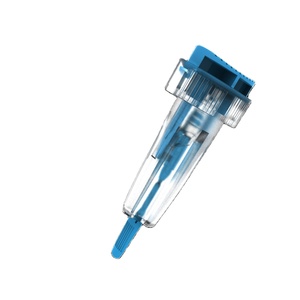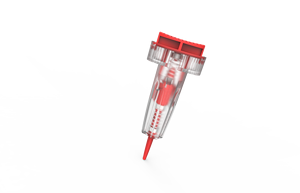
All categories
Featured selections
Trade Assurance
Buyer Central
Help Center
Get the app
Become a supplier

(10 products available)














































The world of medical consumables is vast and varied, with each product playing a crucial role in healthcare settings. Among these, the safety auto lancet stands out as an essential tool for blood collection. Designed for efficiency and patient comfort, these needles are used in various medical procedures to safely draw blood for testing and analysis. Their design ensures minimal discomfort while maintaining the sterility and integrity of the blood sample. As healthcare advances, the demand for reliable and efficient safety auto lancet continues to grow, highlighting their importance in the medical field.
Blood collection needles come in different types, each tailored for specific medical needs. The most common type is the straight needle, which is often used in routine blood draws. Another popular variant is the butterfly needle, known for its winged design that offers better control and is preferred for patients with small or fragile veins. The gauge of the safety auto lancet is another consideration, with sizes ranging from 18 to 25, depending on the procedure and patient requirements. Smaller gauges are typically used for pediatric or geriatric patients, while larger ones are reserved for rapid blood collection. The diversity in types ensures that healthcare providers can select the most appropriate needle for each situation, optimizing patient care and sample quality.
The primary function of a safety auto lancet is to facilitate the safe and effective withdrawal of blood from a patient. These needles are designed with precision to ensure a smooth puncture with minimal pain. Key features include a sharp bevel, which allows for easy penetration of the skin, and a siliconized coating that reduces friction, further minimizing discomfort. Safety is paramount, and many safety auto lancet now come with protective shields or retractable designs to prevent needlestick injuries, safeguarding both healthcare workers and patients. Additionally, these needles are often color-coded by gauge size, making it easier for medical staff to quickly identify the correct needle for the task at hand. The combination of these features ensures that blood collection is both efficient and safe.
The construction of a safety auto lancet involves the use of high-grade materials to ensure durability and sterility. Stainless steel is the material of choice for the needle itself due to its strength and resistance to corrosion. The hub, which connects the needle to the syringe or blood collection tube, is typically made from medical-grade plastic, ensuring a secure fit. Some needles also incorporate a thin layer of silicone to enhance smoothness during insertion. All materials used in safety auto lancet are carefully selected to meet stringent medical standards, ensuring they are biocompatible and free from contaminants. This meticulous choice of materials guarantees that the needles are safe for both patients and healthcare providers.
Proper use of safety auto lancet is critical to ensure patient safety and sample integrity. Before use, healthcare providers should verify the needle's sterility and confirm that it is the correct gauge for the procedure. During the blood draw, the needle should be inserted at an appropriate angle to minimize patient discomfort and ensure efficient blood flow. After use, it is vital to engage any safety features, such as retractable needles or protective shields, to prevent accidental needlesticks. Disposal should follow established medical waste protocols, placing used safety auto lancet in designated sharps containers. By adhering to these guidelines, healthcare professionals can maintain a safe environment while ensuring the highest quality of patient care.
Selecting the appropriate safety auto lancet requires careful consideration of several factors to ensure optimal performance and patient comfort. One of the primary aspects to evaluate is the type of needle, which can range from straight to butterfly designs. Each type serves different purposes, with butterfly needles being particularly advantageous for patients with delicate veins. Additionally, the gauge size of the safety auto lancet is crucial; smaller gauges are ideal for children and elderly patients, while larger gauges are used for rapid blood collection. Understanding these variations helps in choosing the most suitable needle for specific medical procedures.
Another critical factor is the quality of materials used in the safety auto lancet . High-grade stainless steel ensures durability and minimizes the risk of breakage during use. The needle's siliconized coating enhances patient comfort by reducing friction during insertion. Ensuring that the materials meet medical standards is paramount for both patient safety and sample integrity. Compatibility with various blood collection systems, such as vacutainers or syringes, should also be considered to ensure seamless integration into existing medical practices.
When selecting a safety auto lancet , it's important to consider the presence of safety features. Modern needles often come equipped with mechanisms like retractable designs or protective shields to prevent needlestick injuries. These safety features are vital in protecting healthcare workers from accidental exposure to bloodborne pathogens. Evaluating the ease of use of these safety mechanisms can greatly influence the choice of needle, as they should not complicate the blood collection process but rather enhance safety without compromising efficiency.
The gauge size of a safety auto lancet determines the diameter of the needle. Smaller gauges (higher numbers) are used for patients with smaller veins or when minimal discomfort is desired, such as in pediatric or geriatric cases. Larger gauges (lower numbers) allow for faster blood flow and are typically used in emergency situations where quick blood collection is necessary. Choosing the right gauge ensures optimal blood draw efficiency and patient comfort.
Safety features in safety auto lancet are designed to prevent needlestick injuries and ensure the safety of healthcare providers. These features may include retractable needles, which withdraw into the hub after use, or protective shields that cover the needle. Such mechanisms are crucial in reducing the risk of accidental exposure to bloodborne pathogens, thereby maintaining a safe working environment in medical settings.
Material quality in safety auto lancet is essential to ensure the needle's durability, sterility, and biocompatibility. High-quality stainless steel is commonly used for the needle due to its strength and resistance to corrosion. The use of medical-grade plastic for the hub ensures a secure fit with blood collection devices. Choosing needles made from quality materials reduces the risk of breakage and contamination, ensuring patient safety and reliable blood samples.
While many safety auto lancet are designed to be compatible with various blood collection systems, such as vacutainers and syringes, it's important to verify compatibility before use. Some needles are specifically designed for certain systems and may not fit securely or function effectively with others. Ensuring compatibility is crucial for maintaining the integrity of the blood sample and the efficiency of the blood collection process.
Common challenges when using safety auto lancet include selecting the appropriate gauge size for the patient, ensuring the needle is properly aligned for insertion, and managing patient discomfort. Additionally, the risk of needlestick injuries poses a significant concern, emphasizing the importance of using needles with effective safety features. Proper training and adherence to protocols can help mitigate these challenges, ensuring successful blood collection and patient safety.